I can’t stand Elmo, just can’t deal with this damn Muppet anymore. He’s cute, he’s shrill, and he has made Sesame Street worse.
I write this knowing that many people love Elmo, but Sesame Street‘s most-marketed character is an over-exposed drag. He has managed, ironically, to make a children’s show too childish. Thanks in large part to Elmo, Sesame Street is now a less sophisticated and less useful tool for kids to learn from.
This sentiment may hurt, but it’s time to do something about this furry, red problem.
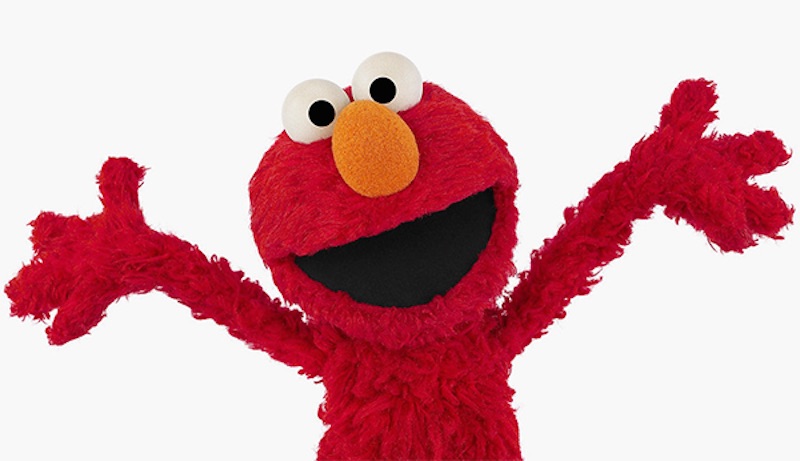
Elmo took a rocky road to his current, unprecedented popularity. Muppets creator Jim Henson believed in allowing a character to grow organically; his guiding philosophy was that each Muppet had a distinct personality; it was the job of the puppeteer to uncover it. Thus, Frank Oz (Grover, Bert) or Richard Hunt (Don Music, Gladys the Cow) or Fran Brill (Prairie Dawn) would slowly experiment with voices and personalities, however long it took, until something stuck.
Nothing, however, seemed to stick for Elmo.
Elmo was a background character starting in the early ’70s, but he never made a mark, and was kicked from puppeteer to puppeteer until 1984. That’s when Hunt, the latest performer to give the furry red monster a whirl, threw the Muppet across the room, where it landed in the hands of Kevin Clash, as the story is explained in a documentary about Clash and Elmo. Hunt, a veteran on Henson’s crew, challenged the young Clash to see if he could devise a new voice.
Hunt hated the little red Muppet, then called ‘Baby Monster.’ He thought Baby Monster was too cutesy, and indeed, the design of Elmo was more adorable and accessible than most Henson creations. The Muppets preceding Elmo were huggable, but they had an edge to them — a bold facial feature or eccentricity that kept them from saccharine territory. And some of the monsters were downright scary looking. Take a look at this guy:
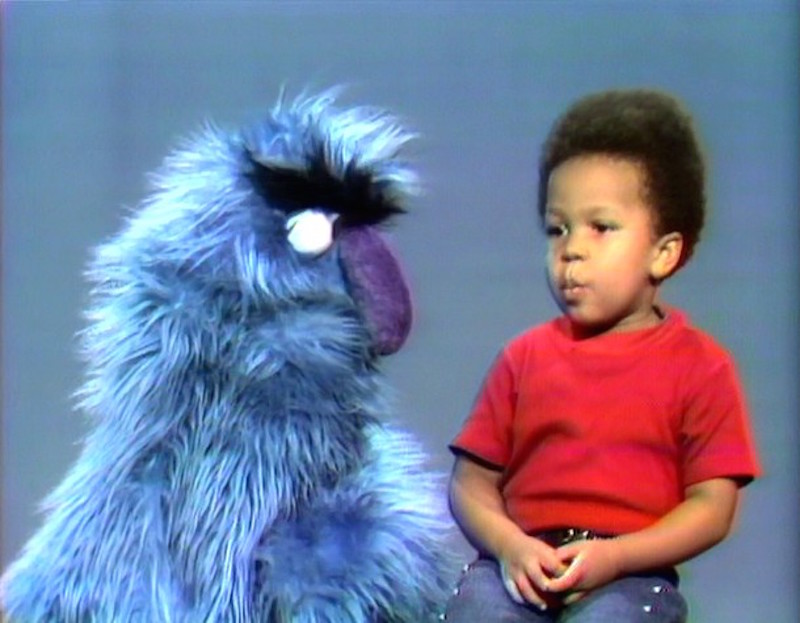
Or this guy:
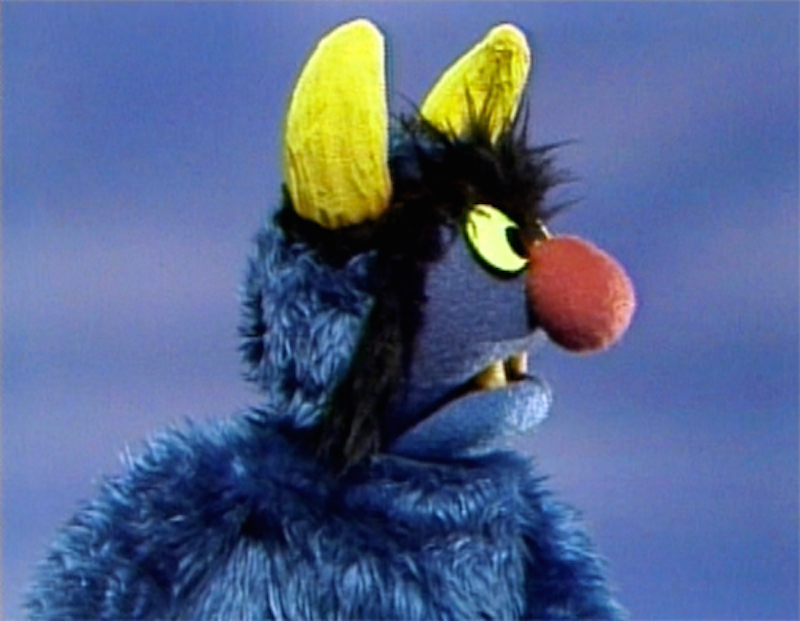
Or how about this guy:
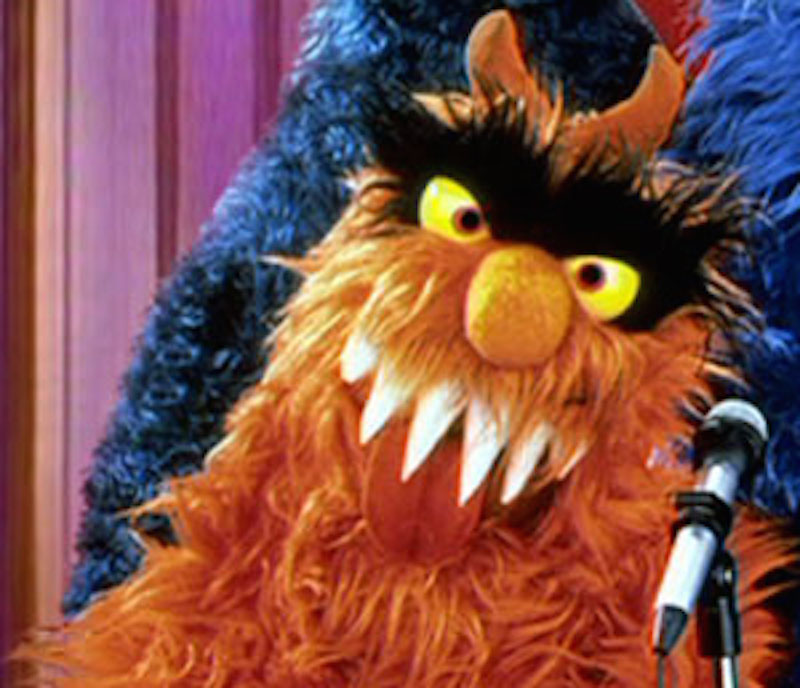
Clash’s interpretation of Elmo aged the character down. Whereas Hunt had given the character a gruff, caveman gimmick, Clash moulded the Muppet into a three-and-a-half-old who embodied love — lots of hugs and lots of kisses. And thus, Elmo was born.
Taken by himself, the character was loveable, but not substantial. His main job was to be unfailingly cute, cheerful, and naive — namely, to act like a happy three-and-a-half year-old. It’s extremely appropriate that Elmo refers to himself in the third person, because Elmo is the only thing that Elmo is concerned with. Other characters were more grounded and had specific, research-based reasons for being on the cast. Oscar the Grouch was created as an indirect representation of the poor and underprivileged — easily judged from the outside, but possessing a good heart on the inside. Herry Monster was a stand-in for every oversized kid, who felt big, awkward, and clumsy versus his peers. Telly Monster stood for all the worries and anxieties that a child might have, when trying new things or confronting old fears.
But Elmo only stood for Elmo — how the world would affect him, rather than how he could affect the world. Or, to paraphrase Louis C.K., three-year-olds are arseholes — they’re selfish and unaware by their very nature. But this wasn’t necessarily a bad thing, especially when Elmo had a foil character, who could highlight his childishness.
Take a look at this early sketch, which pairs Kermit the Frog and Elmo to hilarious effect.
The essential thing to note is that Kermit garners our sympathy. Elmo is cute, sure, but he’s also a massive pain in the arse. This is the sort of dynamic that the Muppets thrive upon — taking two characters, and letting their differing personalities drive the sketch — Elmo’s relentless, oblivious enthusiasm versus Kermit’s patience and overall squeamishness.
There are many antagonistic, odd couple pairings on Sesame Street, just like this one. Bert and Ernie. Prairie Dawn and Cookie Monster. Grover and Mr. Johnson. We loved Ernie, Cookie Monster, and Grover, and laughed at their antics. But at the same time, we knew that we shouldn’t behave like them in public.
The same used to be true for Elmo. He may have been closest to his audience’s age, but he was not the one that the kids were meant to aspire to. Like in this sketch, where Ernie clearly takes a big brother role in the dynamic.
Elmo was one small part of a large, repertory cast, which is how it should have remained. But at some point in the mid-’90s, Elmo began to hog more and more real estate on the show.
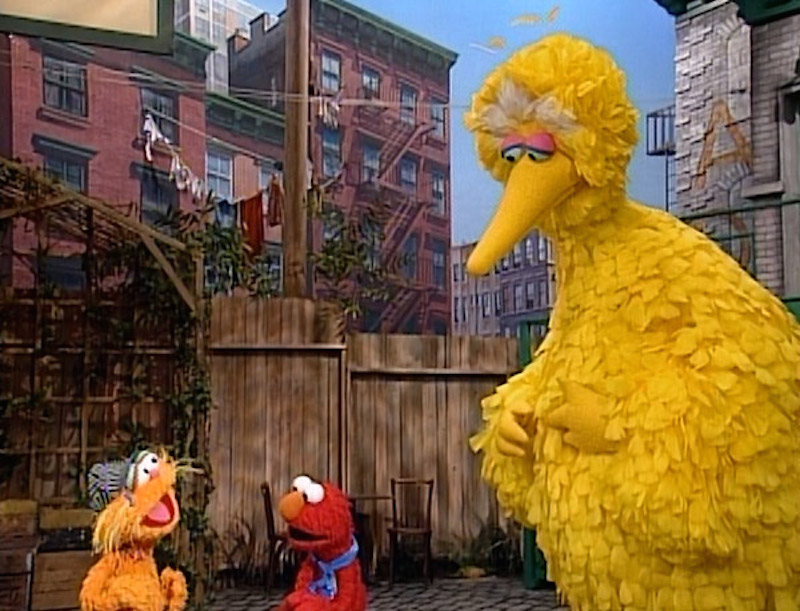
It started in small ways. A lot of stories used to be based around Big Bird, who was psychologically characterised as a six-year-old. And in a lot of ways, this was ideal — six years old was on the older end of Sesame Street‘s age demographic, and Big Bird served as both a role model and a peer to his audience. Big Bird’s comparative maturity also meant that he could project a wide range of emotions — he was ‘old enough’ to understand mature concepts, such as the permanence of Mr. Hooper’s death.
The writers even felt confident enough write a divorce storyline for his best friend Snuffy — although that episode would be nixed before it went on the air. And more recently, Big Bird’s nest was destroyed in a storm — a story inspired by Hurricane Katrina. The writers could always trust Big Bird to tackle emotionally complex issues about loss and its consequences.
Elmo stories, on the other hand, tend to affirm and celebrate the child’s perspective. Rarely, if ever, is Elmo’s innocence challenged, or is he forced to think about someone’s happiness other than his own. He spends most of his time hanging out with Zoe, Abby, Telly, and Baby Bear — Muppets who share his emotional maturity, and unlike Grover, Kermit, and Ernie, do nothing to push him. In fact, he is the de facto leader of his group — the dialogue lowers to Elmo’s level, rather than rising to an older character’s. And while this is cute and fun, it gets old fast, and it doesn’t really go anywhere. Elmo is learning about counting to four and different shapes, but he’s not learning a whole lot of life lessons.
At his worst, Elmo encourages immature behaviour rather than discouraging it. I remember a storyline years ago that perfectly encapsulated this: Episode 3280, Season 26. The storyline begins with Gina’s boyfriend, Jesse, reading a story to Elmo and his friends. After Jesse is finished, all the kids want to take the book home. But, luckily Jesse has a copy for each of them. It was a cheap dodge to a teachable moment.
Later, Gina and Jesse plan a picnic date. Elmo wants to tag along — in fact, he assumes he’s tagging along and gears up, without asking for permission. Gina tells him that this picnic is for grown-ups. Elmo is visibly sad and downcast. He guilts the couple. So the boyfriend cracks and lets Elmo tag along. No gentle reprimand. No establishment of boundaries. Just a full-on, unreserved capitulation to Elmo’s wants and needs.
“YAAYY!!”
What message does all this send? It’s easy to imagine Gina telling Big Bird, “Sometimes, Big Bird, adults need time too. If you want to go to the picnic you should ask for permission.” Nah. Elmo’s method is better. Intrude on personal space! Whine and quiver your lip, kids! Guilt gets things done! Cuteness will get you everywhere!
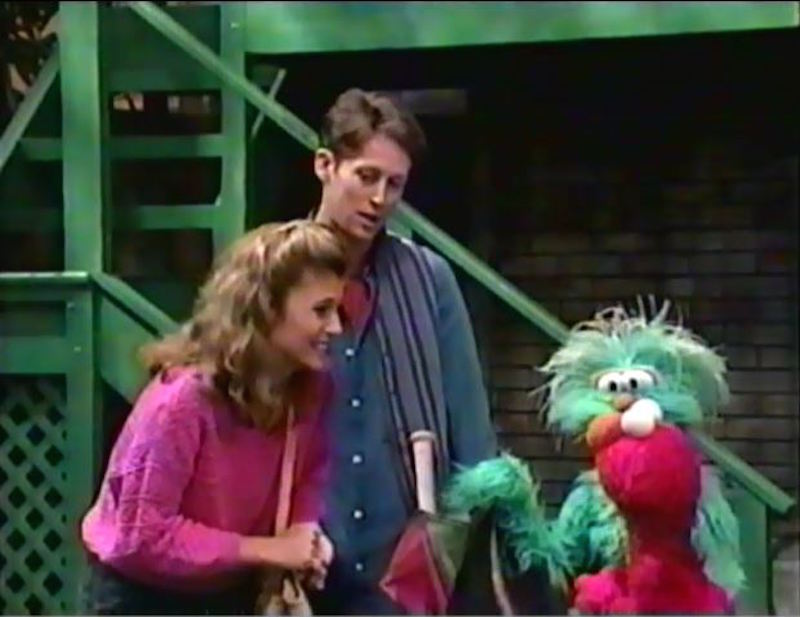
That’s not to say that Elmo does not occasionally star in ‘serious sketches’ — he does. A new friend might be autistic or be HIV Positive, and Elmo helps to dispel common myths and stereotypes. That’s fantastic, but notice how it’s always about what he can do to help others fit in — he’s never had to fit in himself. He never experiences the pain directly — he always experiences it secondhand, from the perspective of an outsider looking in.
And then there’s the 9/11 episode, which, again, missed a teachable opportunity. When Hooper’s Store almost burns down, the firefighters take him around the firehouse to show him there’s nothing to be scared of. The resolution is too simple and immediate: Elmo’s scared and then Elmo’s happy again. He expresses his fears principally through body language and silence; he doesn’t ask the questions that many kids would need the answers to.
Big Bird, on the other hand, always vocalized his concerns directly, and wrestled with scarier, connected questions about abandonment. And Big Bird held onto those sad memories afterwards, even after he made peace with them; that hand-drawn picture of Mr. Hooper hung by his nest for years.
Now admittedly, it’s impossible to get a three-year-old like Elmo to care about someone’s needs before his own, let alone ask important, deeper questions about solitude and personal safety. But that’s exactly my point; a three-year-old Muppet should not be the lead for this show. Elmo used to embody childlike characteristics that children should be moving away from. But now, he’s modelling, for four and five-year-old children, behaviour they should have already left behind. The show used to recognise this and poked gentle fun at Elmo’s immaturity. But in recent times, the writers have forgotten to.
Elmo’s omnipresence also comes at the exclusion of the remaining cast. So many characters, both human and Muppet, have been all but evicted from Sesame Street. Herry. The Two-Headed Monster. Grover. Prairie Dawn. The majority of their appearances are from old, recycled sketches. They have been reduced to side characters and are rarely given big storylines or equal screen time.
And the newer Elmo playmates? They’re lamer substitutes for the original Muppet cast members, and they interact almost exclusively with other Muppets their age. Zoe was, for all intents and purposes, a girl Elmo, who was researched for appeal and mass consumption. Baby Bear had no personality aside from acting like a baby. Abby Cadabby was cute, sure. But remember when Muppets didn’t have to be cute? Abby was a magical girl stock character, created with marketing near the forefront.
The Elmo obsession reached its nadir when the writers started “Elmo’s World.” For an entire decade (1999-2009), Sesame Street dedicated the last 15 minutes of its show to this ridiculous pile of pap starring Elmo. No one else. Just Elmo speaking to the camera, a goldfish, a weird mime named Mr. Noodle, and a bunch of crayon drawings that established the setting. And it’s not like they fenced off Elmo from the other 45 minutes, which would have allowed them to focus on the remainder of the cast. Elmo would often time star in the main storyline, and in the sketches, and in the concluding “Elmo’s World” segment.
When “Elmo’s World” ended, that wasn’t the end of it. Oh no. Instead, it was replaced with “Elmo the Musical,” a new 15 minute segment with more songs, more locations, and more CGI Muppets — a horrifying, recent trend, which does a lot to strip away the show’s warmth. And like “Elmo’s World,” “Elmo the Musical” is almost completely disconnected from the rest of the street. Elmo disappears into his own little technicolour world of fantasy and imagination. That leaves his audience’s imagination behind, by doing all the mental work for them.
The show’s Elmo obsession shows little sign of stopping — he’s the ‘go to’ for talk show appearances and celebrity cameos. Marketing continues to place him from and center, often with no one accompanying him. His commercialized face is plastered everywhere. And that’s unfortunate. It’s a blow to the show’s diversity and integrity, and it’s a blow to fans like me, who have followed Jim Henson and all things Muppet-related for 30+ years.
The new HBO version of Sesame Street will not stem the tide. They have already announced that Elmo will be one of the main characters on the show (they’re actually limiting the cast of Muppets even further). And since the show is now going to run for half an hour instead of its usual hour-length, the fight for character time is going to be even more fierce.
I’m doing something about this.
I have a 13-month-old son, and my wife and I have laid down some basics boundaries for his protection. No cable news on TV — he may not be able to speak, but he still can pick up on other people’s stress. No daily photo updates on Facebook — he’ll have plenty future opportunities to document his entire life on social media, should he choose to do so in the future.
And no Elmo merchandise. Is this petty? I don’t care. I’m not getting involved. If he appears as a side character in a book, fine. If he appears in some group sketch with other Muppets, I’ll look the other way. But for all intents and purposes, Elmo products are banned.
We’re a Grover family, the whole way. Now there’s a Muppet who never talked down to or regressed his audience. Grover would bust his furry blue butt to teach a lesson, even if he had to run himself into the ground to do it.
My son has a Super Grover doll, complete with a helmet and cape that he loves. When we go to a bookstore, I try to find Sesame Street books that star non-Elmo characters. This is an arduous task; 99.9% of modern Sesame Street books are Elmo-centric, but I do what I can, and I also find a lot of the older, out-of-print books on Amazon. We watch classic Sesame Street sketches on YouTube together; in most of them, there’s no furry red monster to be found.
I labour under inevitability; eventually, just like death, taxes, and unrequited love, my son will be exposed to Elmo, especially if he watches the TV show. As a father, all I can hope for is that I’ve taught my son to know right from wrong.
Kevin is an AP English Language teacher and freelance writer from Queens, NY. His focus is on video games, American pop culture, and Asian American issues. Kevin has also been published in VIBE, Complex, Joystiq, Salon, PopMatters, WhatCulture, and Racialicious. You can email him at kevinjameswong@gmail.com@kevinjameswong.
Top illustration by Sam Woolley. Sesame Street screengrabs via the Muppet Wikia.
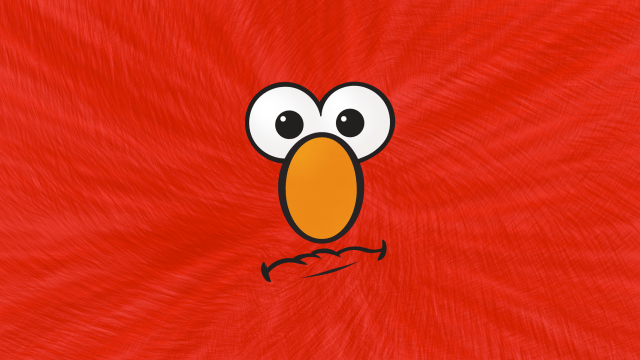
Comments
22 responses to “How Elmo Ruined Sesame Street”
And the pupeteer is a pedo
I thought I was just an old grumpy ass when I occasionally see shorts of these “new” Sesame Street eps and just think to myself good grief just how damned shallow is Sesame Street these days?
I saw a good 10 minute sketch of Elmo going out camping w/ a friend in the woods… and all I got was elmo is happy outdoors! elmo is happy friends are here! oh great more friends means elmo and everyone is happier!
… not once was there any of that witty banter from the early Sesame Street I watched and not once did they even try to ninja anything educational like suddenly start counting stones, talk about flowers and colors… NOT ONCE.. just “everyone is happy coz there’s more friends now camping coz they randomly turned up”
Ok…. so I guess I *am* a cranky old ass w/ that rant… but it’s a bit sad to see my initial suspicions that the show I used to love has now been thoroughly “dumbed down” so to speak.. which is sad because for an educational kids show it had so much depth back in the day.
Oh and I’m sorry it’s either Cookie Monster or the comedic antics of Bert & Ernie (a really amusing kiddy version of Odd couple) for me thanks!
Well said. Elmo HAS ruined Sesame Street. Bert and Ernie, Oscar and Slimy, Big Bird and Snuffy – these pairings have some depth. Grover and Telly were also really interesting characters. Elmo is just a vapidly hyperactive toddler. Fuck Elmo. My kids would rather watch stuff like Peter Rabbit, Tree Fu Tom, Fireman Sam and the like, where there are still moral lessons to be imparted. The heroes of the stories are flawed and are often brought face to face with their faults in order to overcome them. Sesame Street has degenerated into Teletubby-like inanity.
Certainly can’t disagree
I miss Kermit de frog.
So basically after over four thousand episodes over 46 seasons, the writers have gotten lazy?
If they were the same writers from the beginning, I certainly wouldn’t hold it against them, but certainly the writers now seem to be of a breed that promotes the non-confrontational non-competitive ‘everyone wins a prize’ mind-space that today’s youth seem to be drowning in. It’s a real shame.
I think it’s true that the advice of child psychologists (which really only became a thing from the 80s onwards) has been taken too liberally by educators, and now they’re having to wind back the praise to try and help kids develop some semblance of resilience. One good thing, though, to come from the positive parenting movement is that it’s unacceptable to beat the shit out of children when they do something wrong (certainly it no longer happens in schools).
Little twerp even got to be the one to prove Snuffleupagus was real, not Big Bird. Before he started taking over the show, so that should have been a warning sign.
On a side note… I cannot freaking believe that those “classic” Sesame street eps were given “more adult ratings” over PG because… Snuffy is a pot head! And he promotes smoking weed!
Why? because he talks and walks so slowly and slightly slurred like he was high… and he was an “imaginary friend” and can be construed by kids as “a drug induced hallucination”. I won’t even get started on the crap they pinned on Cookie Monster and Oscar
Good grief what a world we live in today =/
No wonder I identified with Snuffy so much, then…
Of course, C.M and Oscar were my favourites as well, so everything you said made me sad a bit.
I can’t help but feel that TV producers these days feel obliged to put a child in almost everything for fear that kids won’t be able to relate to it otherwise, which anybody who remembers their childhood knows isn’t the case.
I say that assuming Elmo is a child. He may just be severely mentally handicapped.
Thanks, Michael Bay. :/
Thanks, Phantom Menace :/
The problem isn’t that though…. i mean classic Sesame had real live kids in the skits and segments all the time!
The problem is that producers tend to equate being a child = childish/selfish immaturity. Not the positive inquisitive naivette like the original Elmo skits… just plain “I’m a kid and I want this or else I can’t be happy!”
Confrontation? Learning a lesson? oh no can’t have those! that’s too adult! It paints a thoroughly unrealistic representation of being a “kid” unless you consider being a spoiled brat as “healthy and normal”
I’m glad I’m not the only one who’s noticed that Elmo is front and centre on Sesame Street these days.
Luckily my daughter never really liked Sesame Street all that much, and now that she’s over 5 and a half she’s not really the target audience anymore. But the times she did watch it, I found myself noticing how much more prominent Elmo had become. And I personally never really liked Elmo as a character, his voice and the way he always spoke in the third person always irked me.
Yes. Grown-ups can see through the charade, and I’m pretty sure 5 and 6 year olds can as well. It’s unfortunate that Elmo is the televisual and intellectual equivalent of going ‘coochie coochie coo’ to a toddler instead of talking to him/her in a normal voice.
I’m just happy Cookie Monster is back to his old self again. I really hated the pushing of the ‘Veggies are better for you than cookies’ thing. It was fun for a few eps I guess but afterwards it just became irritating. At least he gave in to his cravings and decided to eat the show’s props again just like old times. I agree, Elmo is really a massive presence come to think of it, and I’d love to see more of Oscar, Kermit, and Bert & Ernie sketches which have now almost disappeared.
My 2 year old loves Cookie, and the recently new show Furchester Hotel. Elmo is in there too unfortunately, but he totally ignores him. Whenever Cookie appears he laughs and smiles. And you know what? He never comes and whines to us about cookies. Chips on the other hand, that’s a whole other story 😉
I love this article, it explains precisely so many of the things that I don’t enjoy about modern Sesame Street. There are other problems too, such as the overly-long set pieces that seem to have replaced the short sharp skits. Two of the things I really hate from more recent series are “Abby’s flying fairy school” which is an abomination of animation, and those awful, awful cookie monster film parodies. 4 year olds should NOT be watching The Hunger Games or The Lord of the Rings, so why is it in Sesame Street?
Thankfully, there’s plenty of other wonderful children’s television around, and so many new shows are delightful for everyone to watch. And thank goodness Playschool is as good as it ever was.
I disagree with the film parody thing. They probably shouldn’t be watching those films, agreed, but in this day and age the advertising is everywhere and the children will be exposed to it. So if they can at least get a snippet of what it’s all about, that’s ok by me (Disclaimer: I haven’t really seen any of those parodies from recent years. Feel free to disregard my opinion if they’re just a load of trash)
But yeah, I agree with you on the rest. I don’t have kids yet, but when I do, I doubt they’ll be watching Sesame Street. It makes me sad that they will miss out on the characters I grew up with, but it sounds like they would anyway.
I never cared much for the Muppets after becoming a teenager, but they remained a fond memory. Years later I started seeing Elmo everywhere and I was like, who the hell is this red, baby Archibaldo? (that’s how Grover was called in the Spanish localisation) Grover was already awesome enough, why was some palette-swap character necessary? Only now I learn that Grover is no longer in the show, displaced by Elmo. That’s… sad.